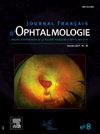年龄萎缩型黄斑变性的诊断方法和治疗途径:法国黄斑变性联合会的建议
IF 1.2
4区 医学
Q3 OPHTHALMOLOGY
引用次数: 0
摘要
萎缩黄斑变性(ADM)是与年龄相关的黄斑病的一种不利发展,其特征是与德鲁氏病、假德鲁氏病和视网膜色素上皮改变相关的进行性视网膜病变。这种形式的DMLA的定义是由于视网膜外层的消失而导致的神经视网膜组织的稀薄。我们的目标是为眼科医生提供管理萎缩性DMLA的诊断和治疗建议,采用标准化的方法,以优化这种病理的管理。萎缩性DMLA的诊断是基于多模态成像:彩色视网膜照相、自荧光底照(FAF)和光学结构相干断层扫描(OCT),这是评估病变大小和小泡节省的一线检查。oct -血管造影(OCT-A)对于诊断相关的脉络膜新生血管是有用的。在某些情况下,鉴别性诊断可能需要额外的检查,如荧光青霉素和/或青霉素血管造影。视觉功能的评估主要基于视力的测量。其他功能测试,如阅读速度、低亮度视觉清晰度(LLVA)、对比度或微周测量,也很有趣,尽管它们还没有在常规临床中使用。这种病理的管理是多学科的:它需要定期的临床监督、医疗、心理支持、矫正康复和光学视觉辅助。患者协会提供了重要的支持。年龄相关黄斑变性(AMD)是一种与年龄相关的黄斑病变的进行性进展,其特征是与黑色素瘤和假黑色素瘤相关的进行性视网膜病变,以及视网膜外层和RPE的改变。它的特点是与视网膜和RPE外层消失有关的神经视网膜组织薄。我们的目标是为眼科医生提供关于萎缩性AMD的诊断和管理的建议,以标准化的方法,以促进和优化这种疾病的管理。萎缩性AMD的诊断基于多模态成像;彩色底片摄影、底片自荧光图像(AFF)和结构光学相干断层扫描(OCT)是评估损伤大小和肺泡节省的一线检查。OCT-血管造影(OCT-A)在诊断相关脉管性新血管形成方面是有用的。有时,鉴别诊断将需要其他补充检查,如荧光和/或靛蓝绿色血管造影。视觉功能的评估主要基于视觉敏锐度的测量;其他功能测试,如阅读速度、低亮度下的视觉敏感度(LLVA)测量、对比灵敏度或微周度,也有明确的兴趣,但尚未在常规临床实践中使用。这种病理的治疗解决方案是多学科的;他们结合定期临床监测、医疗治疗、心理支持、骨科康复和光学视觉帮助。支持小组有显著的好处。本文章由计算机程序翻译,如有差异,请以英文原文为准。
Approche diagnostique et parcours thérapeutique de la dégénérescence maculaire liée à l’âge de type atrophique : recommandations de la Fédération France Macula
La dégénérescence maculaire liée à l’âge (DMLA) atrophique représente une évolution défavorable de la maculopathie liée à l’âge, caractérisée par des lésions avancées de la rétine associées à des drusen, pseudodrusen ainsi qu’à des altérations de l’épithélium pigmentaire rétinien. Cette forme de DMLA se définit par un amincissement du tissu neuro-rétinien lié à la disparition des couches externes de la rétine. Notre objectif est de proposer des recommandations diagnostiques et thérapeutiques pour la prise en charge de la DMLA atrophique, à destination des ophtalmologistes, avec une approche standardisée, afin d’optimiser la gestion de cette pathologie. Le diagnostic de DMLA atrophique est fondé sur l’imagerie multimodale : la rétinographie couleur, les clichés en autofluorescence du fond d’œil (FAF) et la tomographie en cohérence optique structurelle (OCT) qui sont les examens de première intention pour évaluer la taille des lésions et l’épargne fovéolaire. L’OCT-angiographie (OCT-A) est utile afin de diagnostiquer une néovascularisation choroïdienne associée. Dans certains cas, le diagnostic différentiel peut nécessiter des examens complémentaires comme l’angiographie à la fluorescéine et/ou au vert d’indocyanine. L’évaluation de la fonction visuelle repose essentiellement sur la mesure de l’acuité visuelle. D’autres tests fonctionnels tels que la vitesse de lecture, la mesure de l’acuité visuelle en basse luminance (LLVA), la sensibilité aux contrastes ou la micropérimétrie présentent un intérêt certain, bien qu’ils ne soient pas encore utilisés en routine clinique. La prise en charge de cette pathologie est multidisciplinaire : elles nécessite une surveillance clinique régulière, un traitement médical, un soutien psychologique, une réhabilitation orthoptique et des aides visuelles optiques. Les associations de patients représentent un soutien non négligeable.
Atrophic age-related macular degeneration (AMD) represents a detrimental progression of age-related maculopathy, characterized by advanced retinal lesions associated with drusen and pseudodrusen as well as alterations in the outer retinal layers and RPE. It is characterized by a thinning of the neuroretinal tissue linked to the disappearance of the outer layers of the retina and the RPE. Our goal is to offer to ophthalmologists recommendations in the diagnosis and management of atrophic AMD with a standardized approach, in order to facilitate and optimize the management of this disease. The diagnosis of atrophic AMD is based on multimodal imaging; color fundus photography, autofluorescence images of the fundus (AFF) and structural optical coherence tomography (OCT) are the first-line examinations to assess lesion size and foveolar sparing. OCT-angiography (OCT-A) is useful in diagnosing associated choroidal neovascularization. At times, the differential diagnosis will require other complementary examinations, such as fluorescein and/or indocyanine green angiography. The assessment of visual function is essentially based on the measurement of visual acuity; other functional tests such as reading speed, measurement of visual acuity in low luminance (LLVA), contrast sensitivity or microperimetry are of definite interest, but are not yet used in routine clinical practice. The therapeutic solutions for this pathology are multidisciplinary; they combine regular clinical monitoring, medical treatment, psychological support, orthoptic rehabilitation and optical visual aids. Support groups are of significant benefit.
求助全文
通过发布文献求助,成功后即可免费获取论文全文。
去求助
来源期刊
CiteScore
1.10
自引率
8.30%
发文量
317
审稿时长
49 days
期刊介绍:
The Journal français d''ophtalmologie, official publication of the French Society of Ophthalmology, serves the French Speaking Community by publishing excellent research articles, communications of the French Society of Ophthalmology, in-depth reviews, position papers, letters received by the editor and a rich image bank in each issue. The scientific quality is guaranteed through unbiased peer-review, and the journal is member of the Committee of Publication Ethics (COPE). The editors strongly discourage editorial misconduct and in particular if duplicative text from published sources is identified without proper citation, the submission will not be considered for peer review and returned to the authors or immediately rejected.

 求助内容:
求助内容: 应助结果提醒方式:
应助结果提醒方式:


